ACC20013 Company Accounting: Premier Investments Report Analysis
VerifiedAdded on 2022/10/17
|7
|1335
|357
Report
AI Summary
This report analyzes the accounting treatment of Premier Investments Limited, focusing on ASIC's concerns regarding the write-down of $30 million for the casual wear brand name. The report delves into the application of Australian Accounting Standards (AASBs) like AASB 136 and AASB 138, and the Corporations Act 2001, to evaluate the company's actions. It examines the market's reaction to the write-down and the impact of ASIC's inquiries, considering the company's strategy of acquiring strategic shareholdings. The analysis includes a review of the company's impairment testing and the recognition of intangible assets, with a discussion on whether the accounting treatment aligns with the relevant standards. The report concludes that the write-down was appropriate, given the decline in sales and market value of the brand, while also acknowledging the potential for negative market reactions due to the nature of information dissemination in modern times. The report uses relevant references to support its findings.
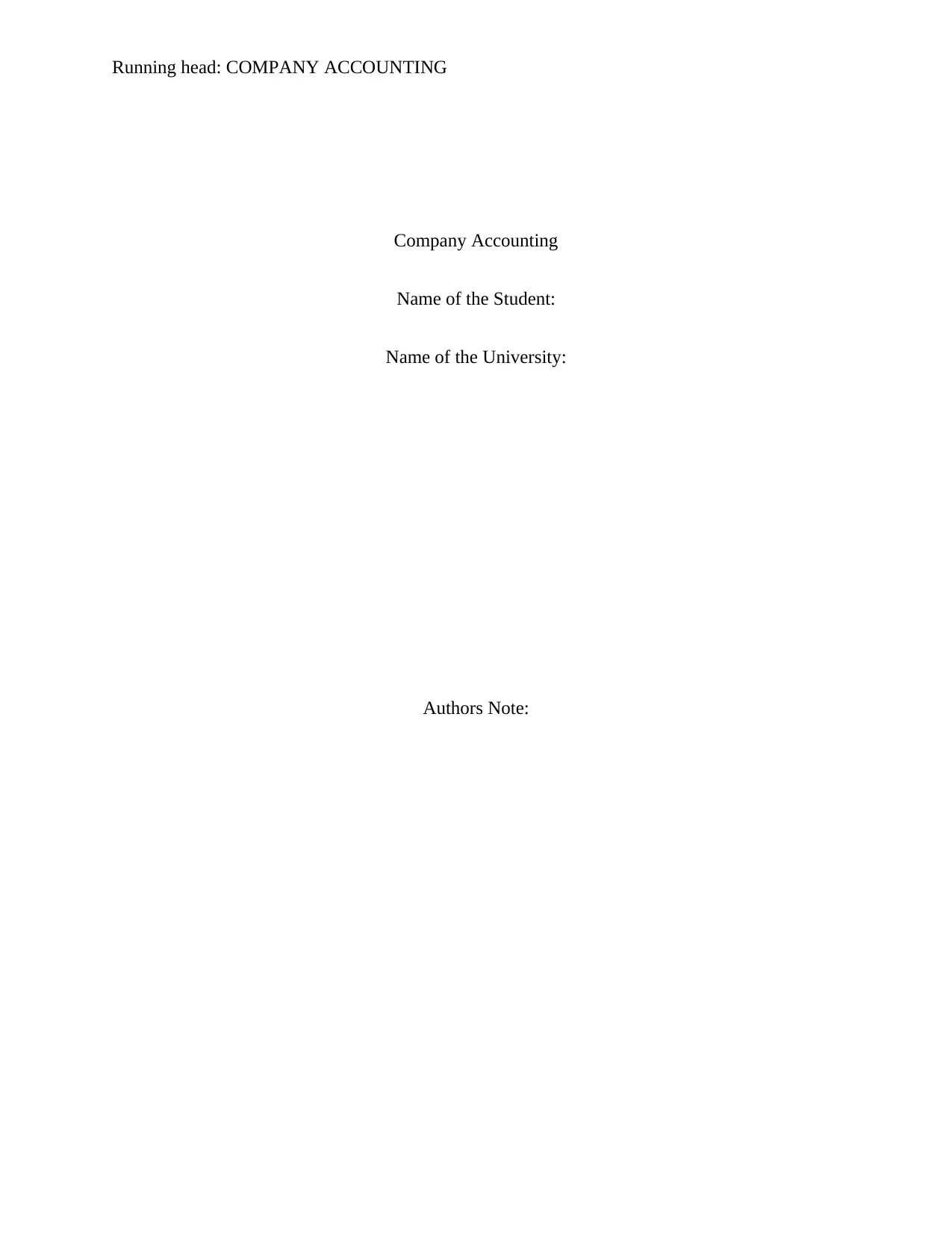
Running head: COMPANY ACCOUNTING
Company Accounting
Name of the Student:
Name of the University:
Authors Note:
Company Accounting
Name of the Student:
Name of the University:
Authors Note:
Paraphrase This Document
Need a fresh take? Get an instant paraphrase of this document with our AI Paraphraser
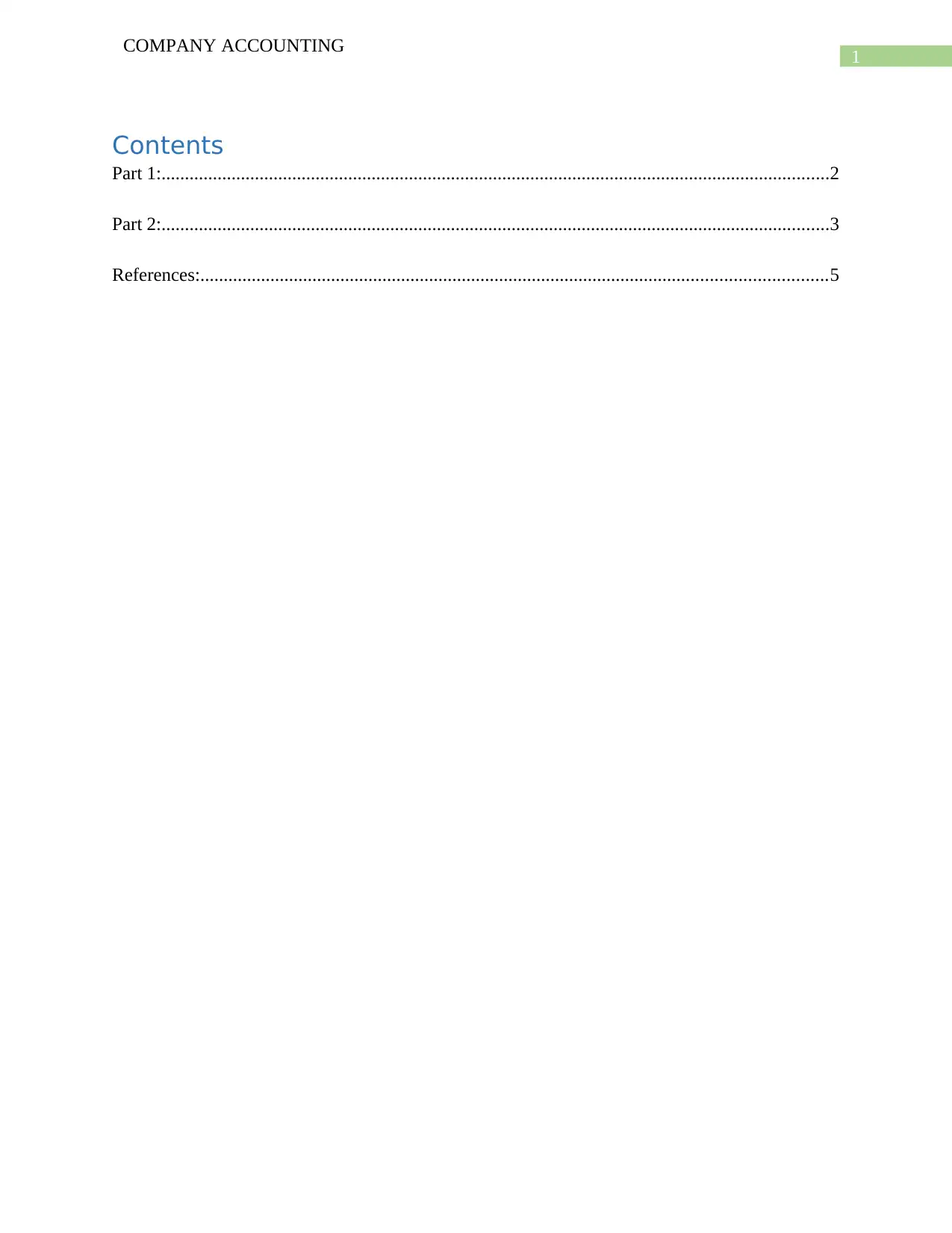
1
COMPANY ACCOUNTING
Contents
Part 1:...............................................................................................................................................2
Part 2:...............................................................................................................................................3
References:......................................................................................................................................5
COMPANY ACCOUNTING
Contents
Part 1:...............................................................................................................................................2
Part 2:...............................................................................................................................................3
References:......................................................................................................................................5
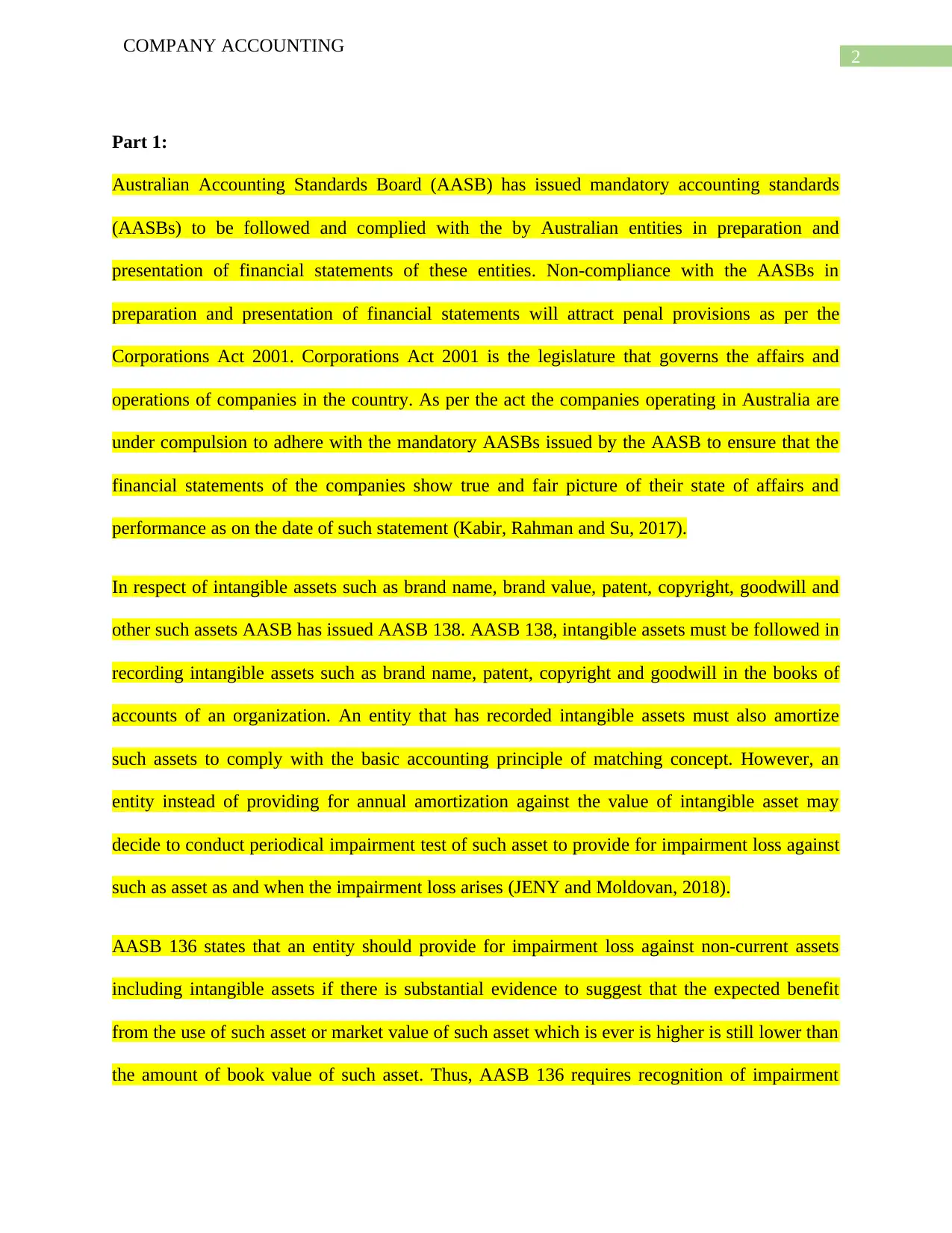
2
COMPANY ACCOUNTING
Part 1:
Australian Accounting Standards Board (AASB) has issued mandatory accounting standards
(AASBs) to be followed and complied with the by Australian entities in preparation and
presentation of financial statements of these entities. Non-compliance with the AASBs in
preparation and presentation of financial statements will attract penal provisions as per the
Corporations Act 2001. Corporations Act 2001 is the legislature that governs the affairs and
operations of companies in the country. As per the act the companies operating in Australia are
under compulsion to adhere with the mandatory AASBs issued by the AASB to ensure that the
financial statements of the companies show true and fair picture of their state of affairs and
performance as on the date of such statement (Kabir, Rahman and Su, 2017).
In respect of intangible assets such as brand name, brand value, patent, copyright, goodwill and
other such assets AASB has issued AASB 138. AASB 138, intangible assets must be followed in
recording intangible assets such as brand name, patent, copyright and goodwill in the books of
accounts of an organization. An entity that has recorded intangible assets must also amortize
such assets to comply with the basic accounting principle of matching concept. However, an
entity instead of providing for annual amortization against the value of intangible asset may
decide to conduct periodical impairment test of such asset to provide for impairment loss against
such as asset as and when the impairment loss arises (JENY and Moldovan, 2018).
AASB 136 states that an entity should provide for impairment loss against non-current assets
including intangible assets if there is substantial evidence to suggest that the expected benefit
from the use of such asset or market value of such asset which is ever is higher is still lower than
the amount of book value of such asset. Thus, AASB 136 requires recognition of impairment
COMPANY ACCOUNTING
Part 1:
Australian Accounting Standards Board (AASB) has issued mandatory accounting standards
(AASBs) to be followed and complied with the by Australian entities in preparation and
presentation of financial statements of these entities. Non-compliance with the AASBs in
preparation and presentation of financial statements will attract penal provisions as per the
Corporations Act 2001. Corporations Act 2001 is the legislature that governs the affairs and
operations of companies in the country. As per the act the companies operating in Australia are
under compulsion to adhere with the mandatory AASBs issued by the AASB to ensure that the
financial statements of the companies show true and fair picture of their state of affairs and
performance as on the date of such statement (Kabir, Rahman and Su, 2017).
In respect of intangible assets such as brand name, brand value, patent, copyright, goodwill and
other such assets AASB has issued AASB 138. AASB 138, intangible assets must be followed in
recording intangible assets such as brand name, patent, copyright and goodwill in the books of
accounts of an organization. An entity that has recorded intangible assets must also amortize
such assets to comply with the basic accounting principle of matching concept. However, an
entity instead of providing for annual amortization against the value of intangible asset may
decide to conduct periodical impairment test of such asset to provide for impairment loss against
such as asset as and when the impairment loss arises (JENY and Moldovan, 2018).
AASB 136 states that an entity should provide for impairment loss against non-current assets
including intangible assets if there is substantial evidence to suggest that the expected benefit
from the use of such asset or market value of such asset which is ever is higher is still lower than
the amount of book value of such asset. Thus, AASB 136 requires recognition of impairment
⊘ This is a preview!⊘
Do you want full access?
Subscribe today to unlock all pages.

Trusted by 1+ million students worldwide
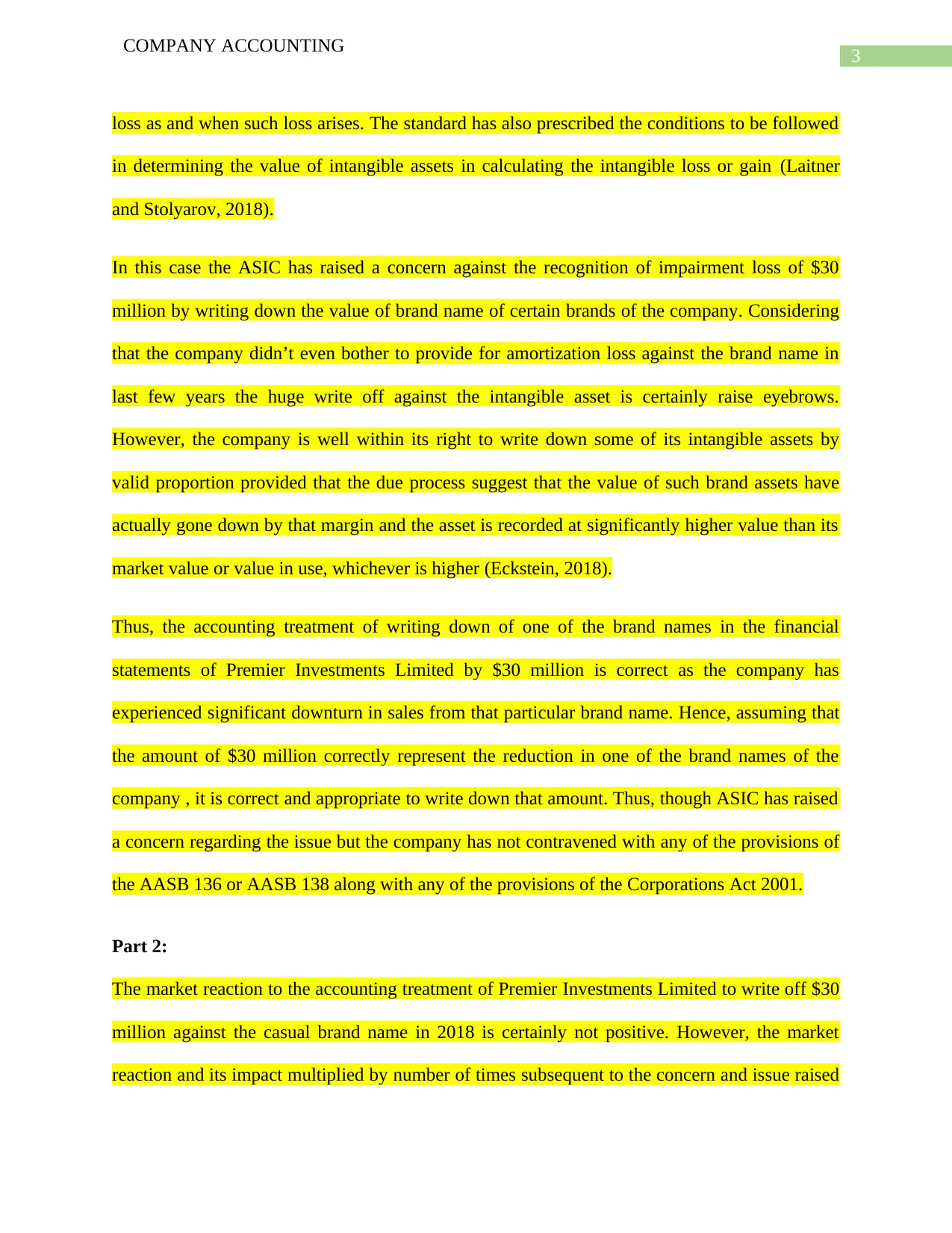
3
COMPANY ACCOUNTING
loss as and when such loss arises. The standard has also prescribed the conditions to be followed
in determining the value of intangible assets in calculating the intangible loss or gain (Laitner
and Stolyarov, 2018).
In this case the ASIC has raised a concern against the recognition of impairment loss of $30
million by writing down the value of brand name of certain brands of the company. Considering
that the company didn’t even bother to provide for amortization loss against the brand name in
last few years the huge write off against the intangible asset is certainly raise eyebrows.
However, the company is well within its right to write down some of its intangible assets by
valid proportion provided that the due process suggest that the value of such brand assets have
actually gone down by that margin and the asset is recorded at significantly higher value than its
market value or value in use, whichever is higher (Eckstein, 2018).
Thus, the accounting treatment of writing down of one of the brand names in the financial
statements of Premier Investments Limited by $30 million is correct as the company has
experienced significant downturn in sales from that particular brand name. Hence, assuming that
the amount of $30 million correctly represent the reduction in one of the brand names of the
company , it is correct and appropriate to write down that amount. Thus, though ASIC has raised
a concern regarding the issue but the company has not contravened with any of the provisions of
the AASB 136 or AASB 138 along with any of the provisions of the Corporations Act 2001.
Part 2:
The market reaction to the accounting treatment of Premier Investments Limited to write off $30
million against the casual brand name in 2018 is certainly not positive. However, the market
reaction and its impact multiplied by number of times subsequent to the concern and issue raised
COMPANY ACCOUNTING
loss as and when such loss arises. The standard has also prescribed the conditions to be followed
in determining the value of intangible assets in calculating the intangible loss or gain (Laitner
and Stolyarov, 2018).
In this case the ASIC has raised a concern against the recognition of impairment loss of $30
million by writing down the value of brand name of certain brands of the company. Considering
that the company didn’t even bother to provide for amortization loss against the brand name in
last few years the huge write off against the intangible asset is certainly raise eyebrows.
However, the company is well within its right to write down some of its intangible assets by
valid proportion provided that the due process suggest that the value of such brand assets have
actually gone down by that margin and the asset is recorded at significantly higher value than its
market value or value in use, whichever is higher (Eckstein, 2018).
Thus, the accounting treatment of writing down of one of the brand names in the financial
statements of Premier Investments Limited by $30 million is correct as the company has
experienced significant downturn in sales from that particular brand name. Hence, assuming that
the amount of $30 million correctly represent the reduction in one of the brand names of the
company , it is correct and appropriate to write down that amount. Thus, though ASIC has raised
a concern regarding the issue but the company has not contravened with any of the provisions of
the AASB 136 or AASB 138 along with any of the provisions of the Corporations Act 2001.
Part 2:
The market reaction to the accounting treatment of Premier Investments Limited to write off $30
million against the casual brand name in 2018 is certainly not positive. However, the market
reaction and its impact multiplied by number of times subsequent to the concern and issue raised
Paraphrase This Document
Need a fresh take? Get an instant paraphrase of this document with our AI Paraphraser
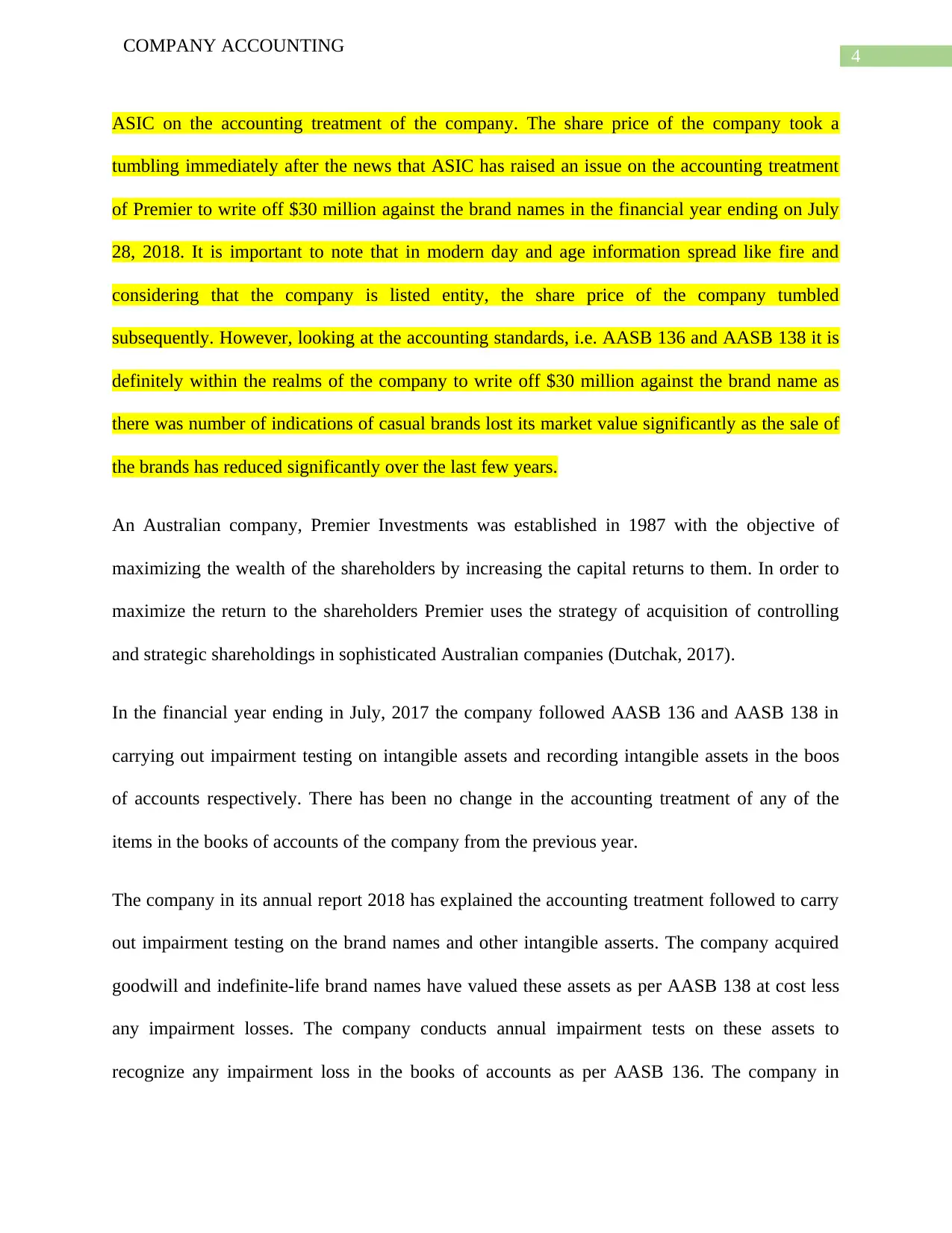
4
COMPANY ACCOUNTING
ASIC on the accounting treatment of the company. The share price of the company took a
tumbling immediately after the news that ASIC has raised an issue on the accounting treatment
of Premier to write off $30 million against the brand names in the financial year ending on July
28, 2018. It is important to note that in modern day and age information spread like fire and
considering that the company is listed entity, the share price of the company tumbled
subsequently. However, looking at the accounting standards, i.e. AASB 136 and AASB 138 it is
definitely within the realms of the company to write off $30 million against the brand name as
there was number of indications of casual brands lost its market value significantly as the sale of
the brands has reduced significantly over the last few years.
An Australian company, Premier Investments was established in 1987 with the objective of
maximizing the wealth of the shareholders by increasing the capital returns to them. In order to
maximize the return to the shareholders Premier uses the strategy of acquisition of controlling
and strategic shareholdings in sophisticated Australian companies (Dutchak, 2017).
In the financial year ending in July, 2017 the company followed AASB 136 and AASB 138 in
carrying out impairment testing on intangible assets and recording intangible assets in the boos
of accounts respectively. There has been no change in the accounting treatment of any of the
items in the books of accounts of the company from the previous year.
The company in its annual report 2018 has explained the accounting treatment followed to carry
out impairment testing on the brand names and other intangible asserts. The company acquired
goodwill and indefinite-life brand names have valued these assets as per AASB 138 at cost less
any impairment losses. The company conducts annual impairment tests on these assets to
recognize any impairment loss in the books of accounts as per AASB 136. The company in
COMPANY ACCOUNTING
ASIC on the accounting treatment of the company. The share price of the company took a
tumbling immediately after the news that ASIC has raised an issue on the accounting treatment
of Premier to write off $30 million against the brand names in the financial year ending on July
28, 2018. It is important to note that in modern day and age information spread like fire and
considering that the company is listed entity, the share price of the company tumbled
subsequently. However, looking at the accounting standards, i.e. AASB 136 and AASB 138 it is
definitely within the realms of the company to write off $30 million against the brand name as
there was number of indications of casual brands lost its market value significantly as the sale of
the brands has reduced significantly over the last few years.
An Australian company, Premier Investments was established in 1987 with the objective of
maximizing the wealth of the shareholders by increasing the capital returns to them. In order to
maximize the return to the shareholders Premier uses the strategy of acquisition of controlling
and strategic shareholdings in sophisticated Australian companies (Dutchak, 2017).
In the financial year ending in July, 2017 the company followed AASB 136 and AASB 138 in
carrying out impairment testing on intangible assets and recording intangible assets in the boos
of accounts respectively. There has been no change in the accounting treatment of any of the
items in the books of accounts of the company from the previous year.
The company in its annual report 2018 has explained the accounting treatment followed to carry
out impairment testing on the brand names and other intangible asserts. The company acquired
goodwill and indefinite-life brand names have valued these assets as per AASB 138 at cost less
any impairment losses. The company conducts annual impairment tests on these assets to
recognize any impairment loss in the books of accounts as per AASB 136. The company in
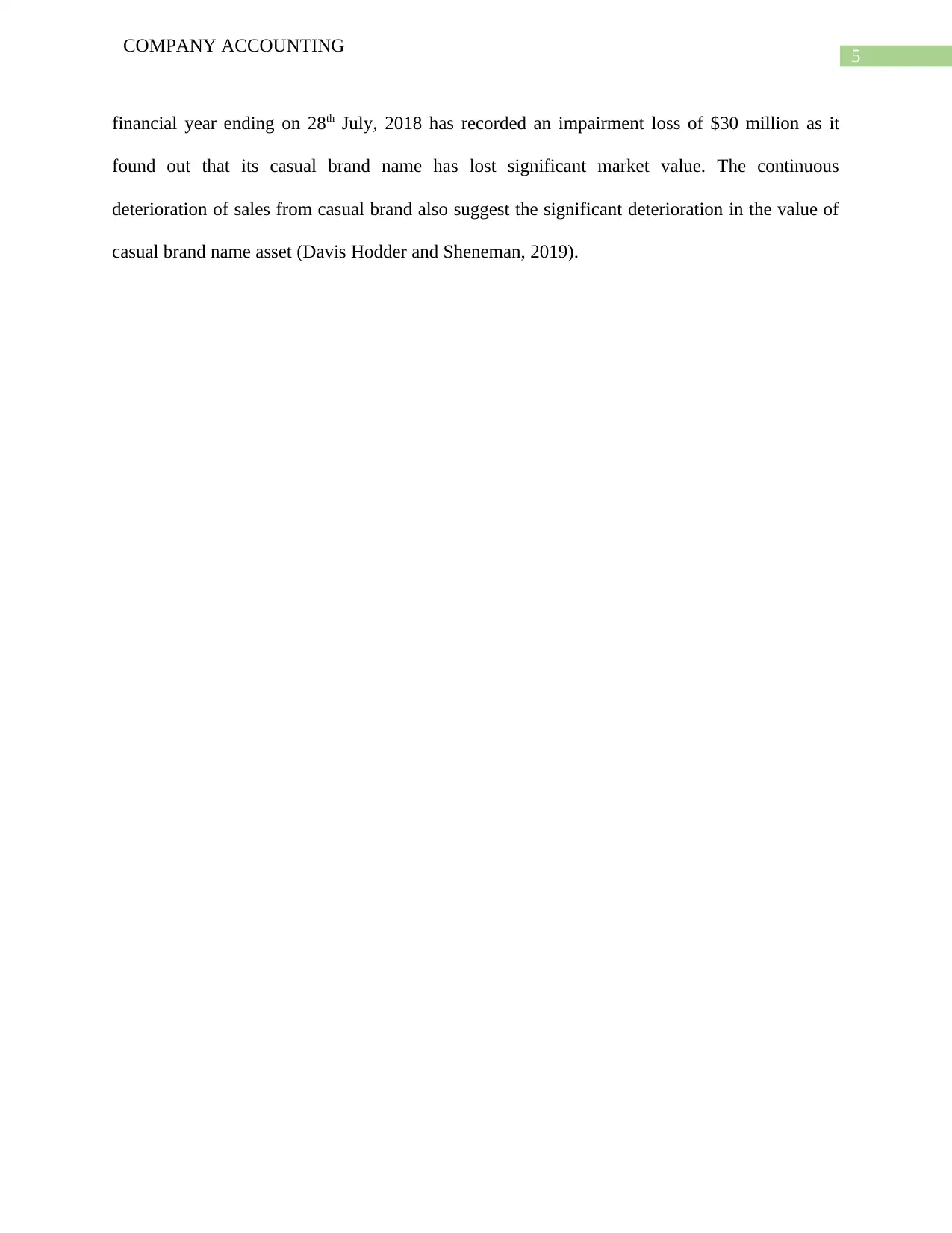
5
COMPANY ACCOUNTING
financial year ending on 28th July, 2018 has recorded an impairment loss of $30 million as it
found out that its casual brand name has lost significant market value. The continuous
deterioration of sales from casual brand also suggest the significant deterioration in the value of
casual brand name asset (Davis Hodder and Sheneman, 2019).
COMPANY ACCOUNTING
financial year ending on 28th July, 2018 has recorded an impairment loss of $30 million as it
found out that its casual brand name has lost significant market value. The continuous
deterioration of sales from casual brand also suggest the significant deterioration in the value of
casual brand name asset (Davis Hodder and Sheneman, 2019).
⊘ This is a preview!⊘
Do you want full access?
Subscribe today to unlock all pages.

Trusted by 1+ million students worldwide
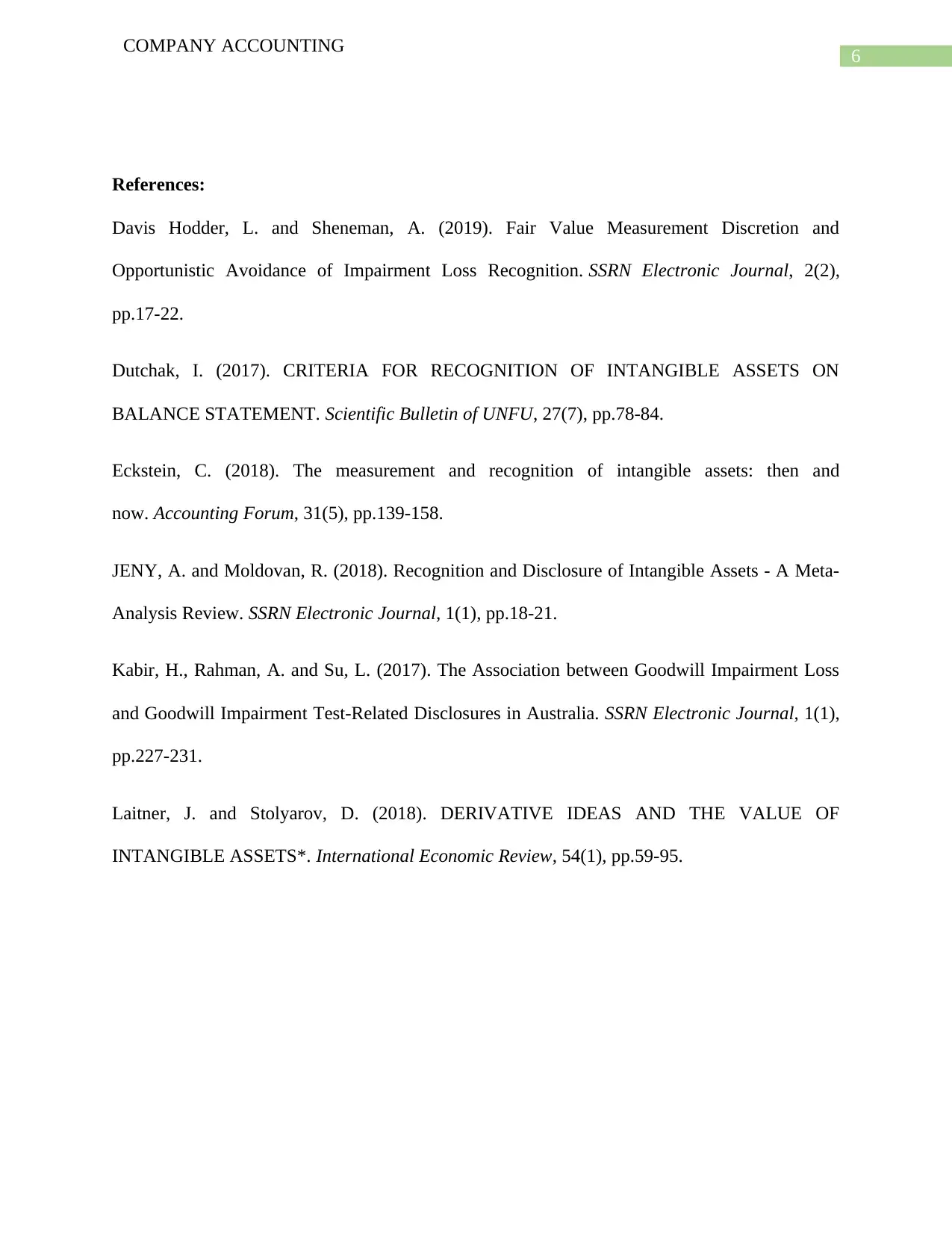
6
COMPANY ACCOUNTING
References:
Davis Hodder, L. and Sheneman, A. (2019). Fair Value Measurement Discretion and
Opportunistic Avoidance of Impairment Loss Recognition. SSRN Electronic Journal, 2(2),
pp.17-22.
Dutchak, I. (2017). CRITERIA FOR RECOGNITION OF INTANGIBLE ASSETS ON
BALANCE STATEMENT. Scientific Bulletin of UNFU, 27(7), pp.78-84.
Eckstein, C. (2018). The measurement and recognition of intangible assets: then and
now. Accounting Forum, 31(5), pp.139-158.
JENY, A. and Moldovan, R. (2018). Recognition and Disclosure of Intangible Assets - A Meta-
Analysis Review. SSRN Electronic Journal, 1(1), pp.18-21.
Kabir, H., Rahman, A. and Su, L. (2017). The Association between Goodwill Impairment Loss
and Goodwill Impairment Test-Related Disclosures in Australia. SSRN Electronic Journal, 1(1),
pp.227-231.
Laitner, J. and Stolyarov, D. (2018). DERIVATIVE IDEAS AND THE VALUE OF
INTANGIBLE ASSETS*. International Economic Review, 54(1), pp.59-95.
COMPANY ACCOUNTING
References:
Davis Hodder, L. and Sheneman, A. (2019). Fair Value Measurement Discretion and
Opportunistic Avoidance of Impairment Loss Recognition. SSRN Electronic Journal, 2(2),
pp.17-22.
Dutchak, I. (2017). CRITERIA FOR RECOGNITION OF INTANGIBLE ASSETS ON
BALANCE STATEMENT. Scientific Bulletin of UNFU, 27(7), pp.78-84.
Eckstein, C. (2018). The measurement and recognition of intangible assets: then and
now. Accounting Forum, 31(5), pp.139-158.
JENY, A. and Moldovan, R. (2018). Recognition and Disclosure of Intangible Assets - A Meta-
Analysis Review. SSRN Electronic Journal, 1(1), pp.18-21.
Kabir, H., Rahman, A. and Su, L. (2017). The Association between Goodwill Impairment Loss
and Goodwill Impairment Test-Related Disclosures in Australia. SSRN Electronic Journal, 1(1),
pp.227-231.
Laitner, J. and Stolyarov, D. (2018). DERIVATIVE IDEAS AND THE VALUE OF
INTANGIBLE ASSETS*. International Economic Review, 54(1), pp.59-95.
1 out of 7
Related Documents
Your All-in-One AI-Powered Toolkit for Academic Success.
+13062052269
info@desklib.com
Available 24*7 on WhatsApp / Email
![[object Object]](/_next/static/media/star-bottom.7253800d.svg)
Unlock your academic potential
Copyright © 2020–2025 A2Z Services. All Rights Reserved. Developed and managed by ZUCOL.



